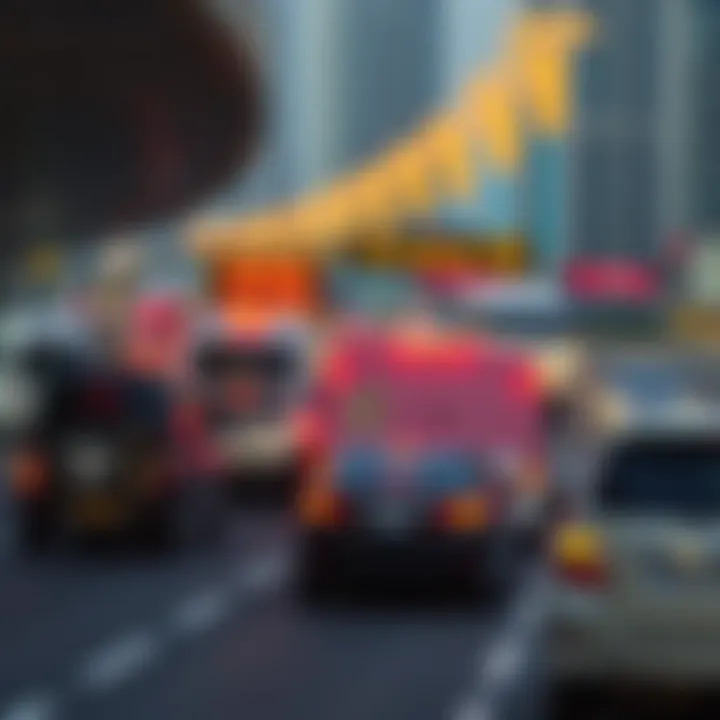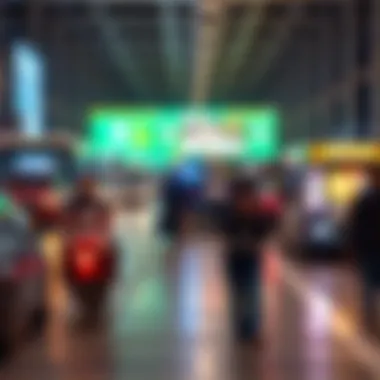RTA Salik System: Impact on Dubai's Infrastructure


Intro
Dubai, a shimmering jewel in the Middle East, has long captured the imagination of investors and expatriates alike. Amid its rapidly evolving urban landscape, the Roads and Transport Authority (RTA) Salik system has emerged as a pivotal element in managing traffic flow and enhancing infrastructure. This article delves into how Salik, Dubai's electronic toll collection system, is more than just a means of charging drivers; it's a catalyst influencing urban mobility and real estate dynamics.
The Salik system was introduced in 2007, and since then, it has transformed the roads of Dubai. Utilizing advanced technology, the system automatically deducts tolls from vehicles passing through designated toll points, allowing for seamless traveling. But beyond the convenience, its implications stretch into economic realms, reshaping not only how residents navigate the city but also affecting property values and urban planning.
Understanding the operational mechanisms and implications of Salik is essential for anyone navigating Dubai’s real estate market. Its presence in the urban fabric does not merely dictate toll pricing but creates ripples in traffic patterns, commercial viability, and the demand for residential properties in various districts.
As we explore the interconnections between Salik and Dubai's infrastructure, we'll analyze current market trends, potential growth areas, investment strategies, and how the public perceives these urban alterations. While the hustle and bustle of everyday life continues unabated, the Salik system quietly influences the trajectory of Dubai, making this a topic worth examining closely.
Prologue to RTA Salik
The RTA Salik system stands as a cornerstone in the ongoing transformation of Dubai's urban landscape. As the city thrives on innovation and modernity, the implementation of this toll system has become a significant highlight in the realm of traffic management and infrastructure development. Understanding the Salik system goes beyond just grasping how it operates; it sheds light on its broader implications for Dubai's real estate market, transportation efficiency, and urban planning strategies.
Overview of Salik System
Launched in 2007, Salik is an electronic toll collection system designed to streamline traffic flow across key routes in Dubai. The system operates without the need for stopping at toll booths, employing a free-flow concept that utilizes RFID technology. This essentially allows vehicles to glide through toll gates, minimizing delays and enhancing the overall commuting experience in a city known for its ambitious projects and rapid urbanization.
The toll gates are strategically placed at critical junctions and roads, such as the Sheikh Zayed Road, which represents a major artery for commuters. By charging a nominal toll for usage, the Salik system encourages a more regulated flow of vehicles, which can lead to a reduction in congestion during peak hours. This mechanism not only saves time for drivers but also has far-reaching impacts on environmental pollution and energy consumption.
Key Features of Salik System
- RFID Technology: Automated toll collection without the need for physical cash transactions.
- Convenience: Users can recharge their accounts online or at designated kiosks, making it user-friendly.
- Efficiency: Aids in alleviating traffic jams and improving air quality by reducing vehicle idling.
The significance of the Salik system extends to various sectors beyond transportation, including real estate. Properties situated close to Salik toll gates experience distinctive valuation trends, often leading to shifts in commuting patterns for residents and their preferences regarding location.
History and Development
To appreciate the current state of the Salik system, it's essential to delve into its historical context and developmental milestones. Initially, Dubai faced considerable challenges regarding traffic congestion due to rapid population growth and urban expansion. This prompted the Roads and Transport Authority (RTA) to reevaluate existing infrastructure and seek effective solutions.
The inception of Salik can be traced back to strategic planning sessions aimed at enhancing traffic flow in a way that aligns with Dubai's long-term growth objectives. It marked a significant shift from traditional toll collection methods to a more innovative, tech-driven approach. Over the years, Salik has undergone numerous updates and expansions to adapt with the city's evolving needs.
The adoption of the Salik system coincided with Dubai's Vision 2021, a national agenda to make the emirate a pivotal hub for economic development. By investing in smart transport solutions like Salik, Dubai not only addressed immediate traffic woes but also set the stage for sustainable urban growth.
"The Salik system reflects Dubai's commitment to leveraging technology for enhancing public services and improving the quality of life."
In summary, the introduction of RTA Salik serves as a critical turning point for urban mobility and infrastructure in Dubai. Its implications stretch across multiple domains, influencing everything from traffic dynamics to real estate patterns. Understanding these nuances is vital for stakeholders, as it can inform better decision-making in investments and urban policies.
Operational Mechanisms of Salik
Understanding the operational mechanisms of the RTA Salik system is crucial for comprehending its broad impact on Dubai's infrastructure and real estate market. This segment delves into how the system functions and the technology that supports it — providing valuable insights for real estate agents, investors, expatriates, and developers.
How the Toll System Works
At its core, the Salik system is a toll collection initiative aimed at managing traffic flow across key routes in Dubai. The system utilizes a simple yet efficient method that minimizes delays for motorists. When drivers pass through a Salik toll gate, a predetermined charge is automatically deducted from their pre-paid Salik account. The process is almost seamless; there are no barriers or stops at the toll points, which significantly reduces congestion during peak hours.
- Account Creation: Motorists must first create a Salik account, where they load their accounts with a minimum amount. This cashless system provides convenience and functionality.
- Tag System: Each vehicle receives a sticker tag that is affixed to the windshield. This tag is the magic key that communicates with the toll gate sensors, ensuring that tolls are deducted accurately.
- Real-Time Management: The system is interconnected with a network of cameras and sensors that track vehicle movements. This integration allows for real-time updates and helps maintain efficiency at toll gates.
Understanding how the toll system works reveals its design intent — to provide not just revenue for infrastructure but also a smoother commuting experience for everyone. By alleviating bottlenecks, Salik indirectly influences surrounding property values by enhancing accessibility.
Technology Behind Salik


The technological backbone of the Salik system is a blend of cutting-edge software and hardware designed to operate effectively in a bustling metropolis like Dubai. It goes beyond just collecting tolls; the system is designed for extensive data collection and traffic analytics.
- Infrared Sensors: These are situated at various toll gates to ensure accurate detection of vehicles passing through. They work in tandem with the tag system to maintain an uninterrupted flow of traffic.
- Data Management Software: A robust backend system analyzes traffic patterns, allowing urban planners to make informed decisions regarding roadway improvements or expansions.
- Mobile Applications: Salik has embraced digital transformation through its mobile app, which enables users to monitor their account balance, view toll transactions, and recharge their accounts effortlessly.
The combination of these technologies not only enhances user experience but also reflects on the smart city vision of Dubai. This interconnectedness supports infrastructure development as it gathers critical data that informs future investments in both highway systems and urban developments.
The Salik system exemplifies how technological integration strengthens urban infrastructure and significantly influences property appreciation in its vicinity.
By understanding these operational mechanisms and technologies, stakeholders can appreciate how essential the Salik system is for Dubai's real estate market. Accessibility provided by efficient traffic management can be a major draw for potential buyers and investors alike.
Impact on Urban Mobility
The RTA Salik system plays a pivotal role in shaping urban mobility in Dubai. With an increasing population and rising vehicle ownership, the city faces significant challenges, particularly in managing traffic congestion. Understanding the implications of this toll system becomes essential for not only policy makers but also for residents, real estate investors, and urban planners alike.
Traffic Flow Improvement
One of the primary benefits of Salik is its contribution to traffic flow improvement. By implementing tolls at key points throughout the city, the RTA effectively encourages drivers to consider alternative routes or modes of transport. This motivation to go a different way often leads to a more dynamic distribution of vehicles across Dubai’s road network.
For instance, imagine during peak hours; the roads around toll gates see lesser congestion compared to earlier scenarios. Commuters who once sat idly in gridlock are now navigating through less crowded paths. Studies indicate a notable reduction in travel times for those using alternative routes, which significantly enhances commuting experiences.
Furthermore, the toll revenue collected is earmarked for upgrading infrastructure and enhancing public transport systems. Improvements in bus routes and the introduction of new services are a direct result of these funds, further promoting public transport usage and reducing the reliance on personal vehicles.
Challenge of Congestion
Despite the improvements, Salik is not without its complications. The challenge of congestion persists in areas that are outside the toll zones. While major thoroughfares might witness smoother traffic flows, lesser-traveled streets can become bottlenecked as drivers avoid tolls. This shift raises questions about the overall efficiency of the urban transport system.
Many residents express frustrations regarding the new dynamics brought about by the toll. As traffic disperses, some neighborhoods face heavier loads. Local roads are often not equipped to handle the increase in traffic volume, leading to wear and tear on infrastructure and safety concerns.
It’s crucial to address these quirks in the system by evaluating transportation patterns and potentially reconfiguring toll zones based on emerging traffic data. Residents and policymakers must engage in a continual dialogue to ensure that while Salik aims to enhance mobility, it doesn’t inadvertently exacerbate congestion issues elsewhere.
"Efforts to improve one area of traffic can unintentionally shift problems to another. Understanding these shifts is key to effective urban planning."
Addressing congestion challenges requires more than just immediate fixes; it requires a comprehensive approach to urban planning that considers future growth and sustainable mobility solutions. This means integrating Salik findings into larger projects that aim to accommodate a growing population while preserving the quality of life for all Dubai residents.
Salik's Influence on Real Estate Market
The RTA Salik system in Dubai is more than just a toll collection mechanism; it has profound implications for the real estate market. As urban landscapes evolve, understanding how infrastructure projects like Salik affect property dynamics is essential for investors, developers, and homeowners alike. With Salik, the impact is twofold—enhancing infrastructure while also influencing spatial value across the city. The proximity of properties to Salik toll gates often becomes a crucial consideration in assessing their market value.
Property Values Near Toll Gates
When it comes to properties situated near Salik toll gates, there's a mixed bag of effects. On one hand, the accessibility provided by these roads may augment property values. Residents often appreciate reducing travel time, leading to a potential rise in demand. For instance, families might opt for homes in close proximity to major highways, as less time spent commuting translates to more time at home.
However, not all is rosy. The cacophony of traffic and the incessant flow of vehicles can drive some potential buyers away, thereby tempering property values. A recent study noted that homes closer to busy toll points might see a drop in demand due to concerns over noise and pollution.
In evaluating this phenomenon, several factors come into play:
- Noise Levels: Adjacent properties may suffer from higher decibel levels, impacting residential appeal.
- Air Quality: Proximity to toll gates sometimes correlates with increased vehicle emissions, influencing buyer sentiment.
- Accessibility: Properties benefiting from enhanced routes often command higher prices in desirable areas.
Ultimately, while being near a toll gate can offer easier access to key areas, potential buyers need to weigh the pros and cons carefully.
Investment Trends Post-Salik


The introduction of the Salik system has indelibly altered investment trends across Dubai's real estate landscape. In its aftermath, investors are making educated decisions based on how infrastructure development shapes market potential. Real estate agents report a notable increase in inquiries about properties strategically situated near Salik routes.
One significant trend observable in the wake of Salik’s implementation is an uptick in development in suburban areas. Investors are drawn to emerging neighborhoods that benefit from reduced commute times facilitated by the Salik system. This convergence of new infrastructure and residential developments is reshaping the city’s growth trajectory.
Several notable investment shifts are emerging:
- Focus on Connectivity: Projects that prioritize accessibility, factoring in toll gate locations, are increasingly attractive to investors.
- Mixed-Use Developments: There’s a rising interest in mixed-use spaces that combine residential units with commercial services, fostering community development.
- Long-Term Value: Investors are beginning to see properties as long-term assets, rather than immediate flips, recognizing the potential of a well-connected location to appreciate over time.
In terms of economic foresight, properties near RTA Salik toll gates can catalyze significant shifts in real estate dynamics, making savvy investments a cornerstone for future growth.
Public Perception of Salik
Public perception plays a pivotal role in shaping the effectiveness and sustainability of the RTA Salik system. Understanding how residents and commuters view the tolling system gives key insights into its acceptability, and future enhancements can be planned accordingly. Addressing perceptions directly can assist stakeholders in fostering a more robust and community-friendly transport environment.
One element that cannot be overlooked is the immediate connection between public sentiment and urban infrastructure. When the community views the Salik system as beneficial, there’s a greater likelihood of compliance with toll payments. This, in turn, leads to increased revenue streams for future infrastructural developments, reinforcing a positive feedback loop.
Community Feedback and Reactions
The feedback from the community regarding Salik is as diverse as it is telling. Many residents have vocalized both support and dissent since the installation of the toll system.
- Supporters often point out the improved traffic flow along major routes, which has, in many instances, made their daily commutes smoother. The convenience gained from reduced congestion is a significant plus, and these respondents frequently express appreciation for the investment in infrastructure.
- Conversely, dissenters raise concerns about the additional costs imposed on commuters, particularly for those who must travel through multiple toll gates to reach their destinations. Such financial burdens can disproportionately impact less affluent populations.
When polls are conducted, it’s notable to see how opinions can shift with increases in transparency and communication from the RTA. Regular updates on how Salik revenue is being utilized—instead of a lack of visibility—could vastly improve public perception.
Behavioral Changes in Commuters
The introduction of Salik hasn’t just altered traffic dynamics; it has shifted commuter behavior too. Since its implementation, several notable patterns in commuter habits have emerged.
- Alterations to routes: Some drivers have begun to modify their travel routes to avoid toll charges, seeking alternative paths that, while longer, save money. This can lead to increased congestion in areas previously less traveled.
- Commuter timing: Moreover, some individuals have adjusted their commute times, opting to travel during off-peak hours when toll costs might be less impacting, or when roads are less congested, leading to a ripple effect on traffic patterns.
As the Salik system continues to be integrated in Dubai’s transport landscape, keeping a pulse on commuter behavioral changes will be essential for ongoing planning. Adaptations in commuting patterns not only influence individual driver experiences but can also ripple through the broader urban infrastructure they interact with every day.
Understanding public perception and commuter behavior is central to the ongoing adaptation and optimization of the Salik system in Dubai. Engaging the community through dialogue and transparency might just be the key to enhancing overall satisfaction and support for this vital infrastructure initiative.
For more detailed insights into the implications of urban toll systems, you can explore resources such as Wikipedia or articles from Britannica.
Economic Implications of the Salik System
The economic implications of the Salik system in Dubai go beyond just simple toll collection. This initiative plays a pivotal role in shaping city infrastructure, urban growth, and the overall economic landscape of the region. Understanding these implications helps in grasping how the toll mechanism supports various aspects of urban life, from revenue generation to community investments.
Revenue Generation for Infrastructure Projects
The Salik system is more than a method of charging for road usage; it stands as a significant source of revenue for infrastructure projects within Dubai. Each vehicular passage through the toll gates contributes funds that are directly allocated to maintain and improve road networks, public transportation systems, and civic amenities.
Some notable aspects include:
- Sustainable Funding: Continuous revenue from Salik helps ensure that infrastructure remains well-funded, promoting sustainability in urban development.
- Investment in Public Transport: Money collected is often funneled into enhancing public transport options, encouraging people to utilize efficient alternatives to private vehicles.
- Road Maintenance: Regular upkeep of roads is a necessity. The funds help maintain smooth and safe driving conditions which ultimately benefits everyone.
Such investments also enhance the attractiveness of the city, making it a thriving hub for businesses and tourism.
The Salik toll system is not merely a fiscal mechanism; it’s a strategy to foster a sophisticated urban ecosystem where sustainability meets economic growth.


Cost-Benefit Analysis
Conducting a cost-benefit analysis related to Salik offers insights into the broader economic ramifications of this toll system. Here's what such an analysis generally reveals:
- Immediate Costs: Initially, the implementation of Salik involved infrastructure costs for installation, technology, and operation.
- Long-Term Benefits: Over time, the revenue generated supports not only road improvements but also boosts the region’s economy by attracting investors and enhancing real estate values.
- Behavioral Changes: The analysis shows that altered commuter behavior, due to the toll, can lead to reduced congestion, which is another economic boon. Time saved in traffic equates to more productive hours.
- Community Investments: With additional funds available, the government can invest in community projects enhancing the overall quality of life, which is a vital consideration for both expatriates and locals.
- Potential Drawbacks: However, it’s essential to consider the effects of increased travel costs on lower-income households, balancing improvements against the financial burden placed on some segments of the population.
In summary, the economic implications of the Salik system reflect a complex interplay of funding, infrastructure development, and community enhancement, creating a dynamic model that other cities might well look to emulate. Implementing such systems is not just about optimizing traffic flow; it’s a component of long-term urban planning and sustainability.
For those in real estate and investment, understanding these subtle dynamics can lead to better-informed decisions, ultimately tethered to the pulse of Dubai's evolving infrastructure.
Future Developments and Challenges
The RTA Salik system represents a pivotal element in Dubai's approach to urban transport and infrastructure management. Understanding the future developments and challenges that lie ahead is crucial for stakeholders involved in the planning and implementation of transportation policies. As the city continues to evolve, so too must its traffic strategies, including the expansion of the Salik network and adapting to the pressures of urban growth.
Potential Expansions of the Salik Network
With the expansion of Dubai’s metropolitan area, there is a pressing need for a more comprehensive tolling system that can accommodate the increasing number of vehicles on the roads. Future developments may include adding additional toll gates and integrating Salik technology into new locations across the city. The goal is to alleviate congestion while also generating revenue for further infrastructure projects.
Potential expansions can be characterized by several key factors:
- Geographic Reach: Initiatives may involve extending the toll network not just to existing suburbs but also into newer areas of urban developments, including satellite cities that are in the pipeline.
- Integration with Public Transport: Plans could leverage synergy with public transport options such as the Dubai Metro and bus systems, possibly providing tax incentives or reduced toll fees for those who utilize such services more frequently.
- Smart Tolling Solutions: As technology continues to evolve, it may be necessary to implement smart tolling systems paired with Artificial Intelligence to manage traffic flow better and optimize toll collection processes.
These developments stand to offer substantial benefits, such as improved traffic conditions and enhanced commuter experiences. As the Salik network updates, the city might expect a reduction in travel time and an increase in the overall quality of life for residents.
Adapting to Urban Growth
Urban growth in Dubai hasn’t just been rapid; it’s been transformative. As more people flock to the city for work and leisure, the RTA needs to ensure that the infrastructure keeps pace with this an increasing population. Adapting to urban growth isn't just about building more roads; it's about smart planning and sustainable practices.
Some significant considerations include:
- Sustainable Development: Future infrastructure projects must prioritize green initiatives, such as promoting electric vehicles or creating integrated transport solutions that minimize carbon footprints.
- Real-time Analytics: By employing data analytics, the RTA can predict traffic patterns and adjust toll rates dynamically, thereby reducing congestion at peak times while maximizing revenue at other times.
- Community Engagement: Keeping an open channel of communication with residents and stakeholders can foster community spirit. It’s vital to consider their input when planning expansions or changes to the Salik system to ensure public buy-in.
Adapting to urban growth is a complex challenge, but with the right strategies in place, the Salik system can become a model for effective urban transport management.
"Smart cities are not just about technology; they are about creating an environment where citizens can thrive."
Investing in the potential expansions and adaptations of the Salik network is not merely a matter of infrastructure; it's about sculpting the foundation of Dubai's future. With careful planning and execution, the city can navigate these challenges and maintain its position as a global leader in urban mobility.
Culmination and Recommendations
The discussion around the RTA Salik system in Dubai has been a comprehensive one, touching on various aspects of urban mobility and its significant influence on real estate. As we reach the conclusion of this exploration, it becomes evident that understanding this toll system is pivotal not only for drivers but also for developers, investors, and policymakers. It serves as a microcosm of broader trends that define the city’s infrastructure and economic landscape.
Summary of Findings
Throughout this article, we have delved into several key facets of the Salik system:
- Operational Efficiency: The Salik toll system operates smoothly with the help of advanced technology, enhancing traffic management and improving urban mobility.
- Economic Context: This system generates substantial revenue for infrastructure projects, which is crucial for a rapidly growing city like Dubai. The funds collected contribute to maintaining and expanding the road network, ensuring the city supports its burgeoning population.
- Public Sentiment: Community feedback reveals a mix of appreciation for reduced congestion and concerns about the financial burden tolls may place on daily commuters. Commuters are adapting, finding alternative routes or adjusting their travel times based on toll charges.
- Real Estate Dynamics: Properties located near toll gates show variable value trends. Investors are increasingly keen on these areas as infrastructure continues to develop.
Strategic Recommendations for Stakeholders
With a clearer picture of the implications of the Salik system, several recommendations can be made for various stakeholders:
- For Policymakers: Armed with data collected from Salik, city planners and policymakers can better anticipate urban growth and identify areas needing infrastructural development. The implementation of further public transport systems can also be prioritized to reduce reliance on personal vehicles.
- For Real Estate Investors: Given the rising property values in proximity to Salik toll gates, there exists an opportunity for savvy investors. It’s prudent to evaluate how future expansions of the Salik network might influence property dynamics in different neighborhoods.
- For Commuters: Understanding the toll implications can empower commuters to make informed choices. Leveraging apps that track traffic and toll prices can help reduce costs and travel times, making daily commutes less burdensome.
- For Developers: Developers should consider integrating transportation solutions into new projects. Properties designed with accessibility in mind can tap into a growing market of residents seeking convenient travel options within an increasingly urbanized landscape.
- For the Community: Advocacy for clearer communication from RTA regarding usage and revenue applications can ease community concerns. A transparent dialogue can build trust and enhance satisfaction among users.
"The landscape of urban mobility is changing, and systems like Salik are both a response and a catalyst for this evolution."
In sum, the RTA Salik system is more than just a toll network; it's a comprehensive framework influencing the very fabric of Dubai's infrastructure and real estate landscape. As stakeholders adapt to these changes, the potential for growth and enhancement of urban life remains significant.











